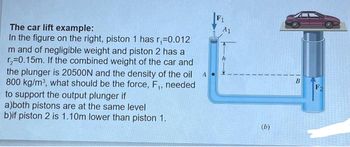Question

Transcribed Image Text:The car lift example:
In the figure on the right, piston 1 has r₁=0.012
m and of negligible weight and piston 2 has a
r₂=0.15m. If the combined weight of the car and
the plunger is 20500N and the density of the oil
800 kg/m³, what should be the force, F₁, needed
to support the output plunger if
a)both pistons are at the same level
b)if piston 2 is 1.10m lower than piston 1.
A1
(b)
B
F2
Expert Solution
This question has been solved!
Explore an expertly crafted, step-by-step solution for a thorough understanding of key concepts.
Step by stepSolved in 3 steps with 2 images

Knowledge Booster
Similar questions
- AST Water is flowing in the pipe shown in the figure below, with the 8.20-cm diameter at point 1 tapering to 3.85 cm at point 2, located y 12.5 cm below point 1. The water pressure at point 1 is 3.20 x 10 Pa and decreases by 50% at point 2. Assume steady, ideal flow. What is the speed of the water at the following points? (a) point 1 x Your response is within 10% of the correct value. This may be due to roundoff error, or you could have a mistake in your calculation Carry out all intermediate results to at least four-digit accuracy to minimize roundoff error. m/s (b) point 2 x Your response is within 10% of the correct value. This may be due to roundoff error, or you could have a mistake in your calculation. Carry out all intermediate results to at least four-digit accuracy to minimize roundoff error. m/sarrow_forwardWater flows at 1 m/s from a hot water heater, through a 410 kPa pressure regulator. The pressure in the pipe supplying an upstairs bathtub 3 m above the heater is 350 kPa. What’s the speed in this upstairs pipe? (Numerical answer is assumed to be in m/s)arrow_forwarda booster motor that has 130psi pressure and a flowrate of 6L/min is connected to a 3/4" hose and 3mm nozzle. what will be the flowrate at the nozzle and the distance of the water assuming a 45 degrees pointing downwardsarrow_forward
- Calculate the Reynolds numbers for the flow of water through a nozzle with a radius of 0.270 cm and a garden hose with a radius of 0.940 cm, when the nozzle is attached to the hose. The flow rate through hose and nozzle is 0.485 L/s. (Assume the temperature of the water is 20°C.) (a) a nozzle with a radius of 0.270 cm Can the flow possibly be laminar? Yes No (b) a garden hose with a radius of 0.940 cm Can the flow possibly be laminar? Yes Noarrow_forwardIf you were to break the 64 mm capillary in half and repeat the flow rate measurement with water, how would your measured values change?arrow_forward
arrow_back_ios
arrow_forward_ios